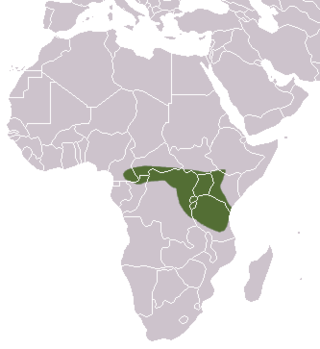Louis Fraser was a British zoologist and collector. In his early years, Fraser was curator of the Museum of the Zoological Society of London.

Franz Ludwig Stuhlmann was a German naturalist, zoologist and African explorer, born in Hamburg.

Edmund Heller was an American zoologist. He was President of the Association of Zoos & Aquariums for two terms, 1935–1936 and 1937–1938.

Theodore Sherman Palmer was an American zoologist.

Tate's shrew rat is a species of rodent in the family Muridae. It is found only in central Sulawesi, Indonesia, where it has been recorded on Mount Latimodjong, Mount Tokala, and Mount Nokilalaki. The species is named after American zoologist George Henry Hamilton Tate.

Euphlyctis ehrenbergii is a species of frog in the family Dicroglossidae. It is endemic to the southwestern Arabian Peninsula in Saudi Arabia and Yemen. It has been treated as a subspecies of Euphlyctis cyanophlyctis, but is now considered as a valid species. The specific name ehrenbergii honours Christian Gottfried Ehrenberg (1795–1876), a German natural scientist.

Rhynchocyon is a genus of elephant shrew in the family Macroscelididae. Members of this genus are known colloquially as the checkered elephant shrews or giant sengis. It contains the following five species:

Hildegarde's shrew is a species of mammal in the family Soricidae. It is found in Burundi, Cameroon, Central African Republic, Republic of the Congo, Democratic Republic of the Congo, Ethiopia, Kenya, Rwanda, and Tanzania. Considered by some authorities to be a subspecies of Crocidura gracilipes, it is now recognised as a separate species, with a diploid chromosome number of 2n = 52. This is one of three species of small mammal named by the British zoologist Oldfield Thomas in honour of anthropologist Hildegarde Beatrice Hinde.

Kihaule's mouse shrew is a species of mammal in the family Soricidae endemic to Tanzania where it is known only from the Udzungwa Mountains, at the western end of the Eastern Arc Mountains. Its natural habitats are subtropical or tropical moist montane forests and plantations. It is threatened by habitat destruction and the International Union for Conservation of Nature has assessed its conservation status as being "endangered". It was named after Philip M. Kihaule, a medical-entomological technician, who considerably contributed to the documenting of the small mammals of Tanzania and collected the type specimen of this shrew.

The Sri Lankan shrew, also called Gordon's pygmy shrew, is a species of mammal in the family Soricidae. It is endemic to Sri Lanka. It is threatened by habitat loss. It is known as හික් මීයා in Sinhala. It was named after the wife of A. C. Tutein-Nolthenius, Marjory née Fellowes-Gordon, who collected specimens of the shrew and provided them to Phillips.

LaVal's disk-winged bat is a species of bat in the family Thyropteridae. It is native to Ecuador, Colombia, Peru, Venezuela and Brazil where it has been found near streams in tropical rainforest. The bat is insectivorous. It is poorly studied but is believed to be rare. The species was named in honor of American zoologist Richard K. LaVal.

Tate's fat-tailed mouse opossum is a species of opossum in the family Didelphidae, named after American zoologist George Henry Hamilton Tate. It is found at elevations of 300 to 3,000 m along the coast of central Peru. The species has the northernmost range of any member of its genus. It has white ventral fur and short condylobasal and zygomatic lengths. T. pallidior is very similar.

Mondolfi's four-eyed opossum is a South American species of opossum found in Colombia and Venezuela, first described in 2006. It inhabits foothills of the Cordillera de Mérida and those on the eastern side of the Cordillera Oriental at elevations from 50 to 800 m. Populations in the two ranges may represent distinct subspecies. It is named after the Venezuelan biologist Edgardo Mondolfi. It has short woolly fur with a pale cream-colored venter as well as large ears pigmented on only the distal half.

Olrog's four-eyed opossum is a South American species of opossum found in eastern Bolivia, first described in 2008 based on specimens collected in 1974. It inhabits the lowland Amazon rainforest, with an elevation range of 150 to 250 m. The species is named after Swedish-Argentine biologist Claes C. Olrog. It is sympatric with P. opossum, which it resembles. The two species differ in several ways, such as ventral fur color and condition of the zygomatic arch.

Reig's opossum is a South American opossum species of the family Didelphidae, discovered in 2004. It is named after Argentine biologist Osvaldo Reig (1929–1992). It was initially found in montane forest in Canaima National Park, Venezuela at an elevation of 1300 m in the Sierra de Lema. It is typically found between 1100 m and 2050 m on Mount Ayanganna.

Carlo von Erlanger was a German ornithologist and explorer born in Ingelheim am Rhein. He was a cousin to musicologist Rodolphe d'Erlanger (1872-1932). (See: Erlanger family tree).

Rudolf Grauer was an Austrian explorer and zoologist.

The Hewitt's red rock hare is a species of mammal in the family Leporidae. It had previously been classified as a subspecies of Pronolagus rupestris, but is now regarded as its own species due to differences in morphology and genetic differences in cytochrome b, and 12S rRNA.
Coua berthae is an extinct species of coua, a large, mostly terrestrial bird in the cuckoo family, from Madagascar. It was the largest member of its genus, living or extinct. It was named in honour of the Malagasy zoologist Berthe Rakotosamimanana.
Geomys streckeri, also known as Strecker's pocket gopher, is a species of pocket gopher found in Texas. It was formerly considered a subspecies of the Texas pocket gopher. Chromosomal analyses have proven this species to be distinct. Analysis of its mitochondrial cytochrome b points to this species being a sister clade to Geomys personatus, Geomys attwateri, and Geomys tropicalis. Other evidence, using a Bayesian analysis of ribosomal RNA and certain proteins, points to it being embedded within the G. personatus clade and being a sister species to G. attwateri.


















